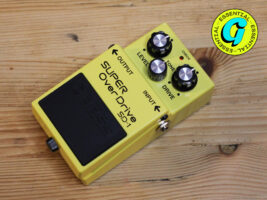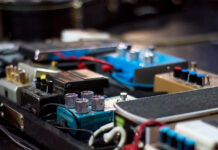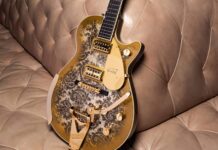
The Boss SD-1 – still the king of the cheap overdrives in 2025?
The venerable Boss SD-1 has been around for over 40 years – and in that time it’s remained one of the best-selling Boss pedals out there, and gained a loyal following who extol its virtues as the mid-pushed mid-gain pedal for all of your overdriving needs.
READ MORE: Cause & Effects: Tube Screamer season has arrived – but why do guitarists love this pedal so much?
But what makes the SD-1 such a classic? Let’s dive into some history and give the pedal a spin to find out.
A Quick history
The 1970s was the decade when the idea of an ‘overdrive pedal’ became its own distinct thing. Fuzzes, boosts and wah pedals had exploded across the 60s – but the overdrive as we know it today began first with pedals like the DOD Overdrive Preamp 250 and the MXR Distortion+. These were both almost identical circuits, with just volume and gain controls – they used newly-available op-amps to boost your signal, and hard-clipping diodes to add distortion. No tone controls here – the EQ behaviour was set, and with those two early examples in particular, the treble response was tied into how much gain you were using.
Boss dipped its toe into this market in 1977 with the OD-1, which notably featured asymmetrical soft clipping – rather than the symmetrical hard-clipping used in both the DOD and MXR circuits. Despite its distinctions from the DOD/MXR approach, though, it was still a fairly simple overdrive with just two controls – and by the late 1970s, things had moved on. The Tube Screamer had arrived, with its tight bass-cut and mid-hump sound destined to shape the harder edges of rock and metal guitar tone for decades to come.
In 1981, Boss launched its Tube Screamer competitor: the SD-1. While it shares a lot of the same broad strokes as the Tube Screamer – it’s an op-amp soft-clipper with a very similar tone stack and overall EQ character – there were a few tweaks that have helped it carve out its own niche.
In use
The most important tweak is that unlike the Tube Screamer’s symmetrical clipping stage, the SD-1 uses asymmetrical clipping, with two diodes for one half of the signal and only one for the other. This change leads to a softer, slightly more harmonically interesting sound – every other wave peak is clipped differently, and so even-order harmonics are slightly accentuated. It’s a style of clipping that’s often said to be closer to tube distortion, and hence cited as more ‘desirable’ – and while both have their uses, it’s certainly a large part of the SD-1’s character.
That character is in part what’s led the SD-1 to have a reputation as a very versatile overdrive. While drives like the Tube Screamer are often used more for their EQ and volume output, the SD-1 will also give you a chewy, responsive sound when used with a pristinely clean amplifier and its own gain control up high.
Regardless of the circuit theory of its clipping stage, the result speaks for itself. I give the SD-1 a test with an ultra-clean Fender-style amplifier – the kind of brittle, splatty sound that some overdrives conjure with this style of amp is absent, even when turning the gain control to maximum – things do indeed sound closer to tube distortion.
But this is ultimately an overdrive pedal, not an out-and-out distortion pedal. So let’s give that a go – switching over to the crunchiness of an Orange OR15 set to medium gain and a flat EQ, the SD-1 brings out a clear, vocal element to the lower midrange, and cuts out any excess thunk in the low-end – while also pushing the amp into a much more saturated territory.
When playing in E standard things get very 1980s very quickly, even through the Orange. And while I don’t have a real Plexi to hand, I do have a UAFX Lion for the all-important Marshall test. The SD-1 and a Marshall is often said to be a match made in heaven, and indeed it is when I try it – especially when using a real power amp with the Lion. The low-end becomes tight and articulate rather than flubby and overwhelming, feedback howls at just the right level and everything pretty much immediately sounds like Iron Maiden.
The tone control’s sweep isn’t huge – I instead find it much better at just refining the midrange character. The active EQ is able to do a more subtle and complex job than the passive filters of pedals like the RAT or the Big Muff, as it can also boost certain frequencies.
Obviously, within the pantheon of mid-push overdrives, people have their own preferences. But it’s easy to see why the SD-1 has stuck around for so many years alongside that meaner, greener take on this style of pedal. While less of us are playing Marshall full stacks these days and desperately need for that low-end cut to have any clarity at all, midrange-pushing will always be relevant. The midrange is, well, where the notes are – and overdrive pedals like these are fantastic at accentuating the relationship between player and amplifier.
The SD-1 is a classic for more than just its sound, of course. Like the Tube Screamer and the Pro Co RAT, you can still grab a new SD-1 for a very reasonable price – £65 in most cases. So if you’re looking to experience overdrive history, I’d heartily recommend at least trying this humble, yellow little overdrive. (One day we’ll figure out why most overdrives are yellow…)
The post The Boss SD-1 – still the king of the cheap overdrives in 2025? appeared first on Guitar.com | All Things Guitar.
Source: www.guitar-bass.net










